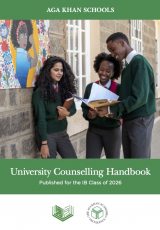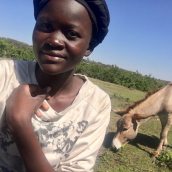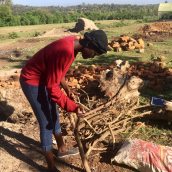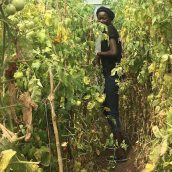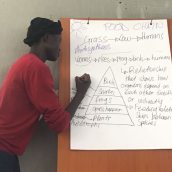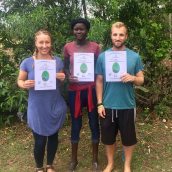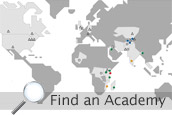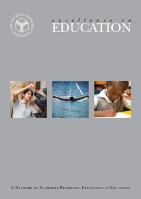Fighting poverty through sustainable agriculture
Agriculture is Kenya’s main economic activity generating almost 90% of Kenya’s exports. In Kenya however, cash crops are grown instead of food crops contributing to the bigger problem of food insecurity within Kenya itself. Many communities growing food crops consist of subsistence farmers who, due to lack of scientific knowledge about the environment, end up exploiting the environment to the extent that agricultural produce reduces.
One surprising thing that I realised while growing up is that even farmers struggle to put food on the table even though they are the primary producers. Living in a farming community that ended up buying farm products from other markets, I realised from a young age that there is a problem with the farming system. This was the beginning of my interest in farming and furthermore rebuilt when my mother started engaging in farming and received even worse output than others. I realised that farmers do invest in their farming business but in all wrong areas. My mother had kept on wondering why she did not really receive any returns, and I grew interest then only to realise that the problem was within the monoculture farming system boosted by chemical fertilizers.
Following the drought in Kenya in 2017, many in the agricultural sector were left devastated due to low yields and high crop prices. My Extended Essay was based on how the extended drought impacted agriculture and with primary research on the farming community of Kunya, Kisumu which was one of the communities heavily impacted by the drought.
From December 18 to 22, I attended an intensive training program for an introduction to permaculture course. This was in Homabay, two hours away from Kisumu and after the terrible yield of 2017, many farmers were more than ready to learn about permaculture. Permaculture is a system of agricultural and social design principles centred around simulating or directly utilising the patterns and features observed in natural ecosystems. This course was centred on educating local farmers of Homabay on ways in which they could improve their interaction with the environment and learn new sustainable farming systems that do not exploit the environment. The course was directed to adult farmers, and I attended as a student interested in agriculture and the environment. Given my interest in Environmental Systems and Societies (ESS) and Geography at school, this was a learning opportunity for me, as well as a platform where I could apply knowledge learnt in class in a practical way.
In an introductory session about permaculture, I learned that the sessions would be focused on teaching about sustainable and environmentally friendly agriculture that can be used to uplift communities out of poverty. At first, we began by familiarising ourselves with the local environment – what it includes, as well as what we give and take from it. As I was learning alongside adults who may not have formal knowledge about the environment, having a brief introduction was to help them understand how the environment relates to agriculture and asses the culture of farming practiced by them.
The first few lessons focused on the environment, the soil and how these can benefit us to make life easier for us. We learnt about practical ways to enrich the soil in order to maximise yields. I was able to directly relate, having learnt about soil systems in school, and with this I got to learn more about soil from a practical perspective. The lessons were interactive; students gave in their input or opinions, and with each topic we got to watch a video with case studies and practical measures to apply what was learnt. This enriched our knowledge further and increased our trust in permaculture. I could draw many parallels between what I had been learning in school and what was being applied here – I clearly saw the various ways I could apply my school knowledge to solve world problems.
On the second day, we learnt about the relationship between the sun and the environment as well as ways of improving soil, compost-making, water catchment systems and landscape for water retention. For this section, we watched videos about soil and Israel’s water crisis – it was all about practical, real-life applications of the theory, similar to the way we learn in class.
As the class was full of subsistence farmers, learning more about the science behind farming enabled them to understand their mistakes in farming, as well as why things occur the way they do and most importantly, ways of improving. On the third day we majorly focused on yield, discussing the yield pattern for the area as well as how to increase yield through diversifying income. We got diverse perspectives on how to ensure greater yield and fight disasters like drought or flooding.
The most meaningful part of the course was when I was chosen to teach the participants. My given topic was the environmental systems alongside food-chain and ecosystems. This made me happy as this was directly what I had learnt in class, and passing this knowledge to adults and helping them know of ways treat the environment better was a great experience.
With everything that I taught I had to translate into three different languages while also allowing different opinions to be expressed. Surprisingly, I realised that most of the participants in the course had a lot of knowledge about the environment, but lacked knowledge about the human impact on the environment. Using the knowledge gained through ESS and Geography, I stood in front a room full of adults to talk about the process of global warming, its causes and effects. This was the moment I received their full attention, with each one of them going silent as they learnt a new concept. Despite knowing so much about the environment and farming, their knowledge about global warming – the biggest fear and threat of our time – was lacking within this community. As we discussed the effects of global warming, the class began to understand why the climate was changing, further explaining the drought crisis that had devastated them. They began to understand in a deeper way why it had stopped raining and why they had been facing increasingly high temperatures. After the session, I felt very encouraged because many of the farmer-students came up to me asking of ways in which global warming can be stopped – they were genuinely concerned and had been catalysed to put an end to global warming.
Through this permaculture course, I had interactions with farmers and learnt more about the environment, but the most important learning to me was how sustainable agriculture can be used to fight poverty; this is the main aim of permaculture. Permaculture is all about bringing people together to practice agriculture that is beneficial to them. The course inspired a lot of hope within all the participants. As a result of this course I could now understand the flaws within the practiced agricultural system and upon return home I spoke to my mother about new practices for the farm. My mother has taken farming for years now but has never been satisfied with the produce, always wondering what she did wrong. Applying new methods would help her get better yields and improve her farming system. The lack of knowledge within many farmers in my community is what had led to loss of faith in agriculture, with it causing even greater poverty rather than development.
However, through this unique experience, I was able to clearly see the relationship between agriculture and development. This also helped me figure out that I want to pursue agriculture as my main area of study at university, and learn more about the connection between agriculture and business after I graduate this May.
By Josephine Awino
publications
